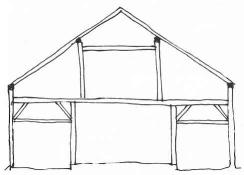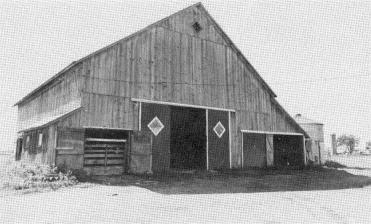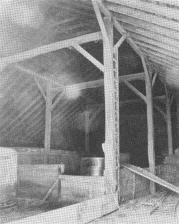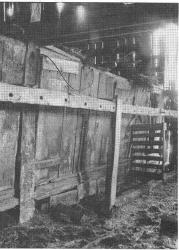NEWSLETTER,
Spring 1991, Vol., 4, Issue 1
The Dutch Influence Alive In
Barns Near Holland, Michigan
Text
and photographs by Peter Sinclair This
article describes a two day inspection of barns in an area
of nineteenth century Dutch settlement near Holland, Michigan.
The first day's tour, organized by Betty Galer of Grandville,
Michigan, took a group of us north and west of Holland, primarily
in Ottawa County. We noted many small barns with high side
walls and entrances on the gable ends. These barns were often
accompanied by a red brick house with decorative use of cream-colored
bricks. Many of the barns were painted red with white trim
on the major doors. We received permission to inspect several
barns, took photographs, made rough drawings and notes, but
did no measurement. The proportions, and the arrangement
of uses, was similar in five barns, designated as Type A.
(See illustrations.) The first barn we looked into, the Sunrise
Acres Farm, had its hay stored on mow poles. There was evidence
of this tradition in most of the barns visited. The second
barn, owned by the De Boer family, was a three-bay barn,
as were many of the Type A barns. The original barn had burned
and the present one is a 60-year-old replacement. The third
barn, the Lanings- De Kline barn in Zeeland Township, was
bought by the present family in 1919. Corner notches in some
of the columns show evidence of built-in mangers. The barn
was raised by the present family to provide a basement for
cattle. The fourth barn, the Vanderkolk-Brouwer barn near
the village of Drenth, was built in 1873. Mrs. Brouwer told
us that the round decorative corners of the painted doors
were formed by using a pie tin. The two-part wagon doors
of her barn were held shut with a removable center post,
the only example of this door latching system which was found
in Michigan. It is common in New York State barns. The Roelos-Zeerip
barn, the fifth barn, was built about 80 years ago by the
grandfather of the present owner. The sawn timbers were brought
by horse and wagon from Holland, Michigan.

Type
A barn. The De Boer barn, red with white trim, has two-part
wagon doors, hung on a track, opening to a center nave. The
small door to the right opens to the aisle. The
drawing illustrates the bents of a Type A barn. The main horizontal
beam is mortised to the side columns and rests on two internal
columns. At center, the rafters rest on purl ins supported
by the queen posts. These Type A bents are designed to divide
the floor of the barn into a central nave for threshing and
unloading wagons, and two side aisles where cattle are kept,
very much as the H-bent of the European and eastern New World
Dutch barns functions.

Drawing of the Type A frame
of the Lanings De Kline barn. By Peter Sinclair.
The tradition
of the eastern New World Dutch barn, which was established
within the Dutch colony in New York and New Jersey by the mid1600's,
persisted until the early 1800's when its design was altered
as it was adapted to new ideas and changes in agriculture.
The later Dutch immigration into the Holland, Michigan area
began in the mid-1800's and its barn construction tradition
was a separate development from the eastern one. It chose a
vertical instead of horizontal siding and did not make use
of the raising hole, common in eastern barns. Despite the differences
in time and geography, the New World Dutch barns in the Northeast
and those in Michigan share a number of features based on their
common roots.
An example
is the sixth and final barn visited on the first day, the Raak
barn. This barn is known locally as "Dutch." It is
a five-bay barn formed with H-bents. It is the only such barn
seen, and is designated Type B.

Type
A barn. The Roelos-Zeerip barn has typical additions on either
side. Cattle in the left aisle are separated from the center
by a plank wall with horizontal "Dutch" doors that
open down for feeding.
Although Type B is more similar to the eastern barn than Type
A because of the Type B use of the H-bent, there are a number
of differences. The wagon doors open into the right aisle rather
than the central nave. The anchorbeam is 16 1/2 feet above the
floor where 11 feet is normal in the northeastern barn. The Raak
barn has two side aisles on one side, no transverse struts connecting
the columns and posts in its right aisle, and no longitudinal
ties between the columns on this aisle. The barn, which measures
62 feet wide and 75 feet long, is an example of the great simplicity
and economy of means made possible by a Dutch framing system.
The second day I went alone to inspect barns in likely areas
of Dutch influence south and west of Holland, primarily in Allegan
County. I found many large barns there. Almost all had their
entrances on the gable end and many had very low side walls,
in Dutch fashion. Some had a simple gable roof line, and others
had a gambrel roof. Those with a simple roof line I have designated
Type C. I did not examine any of the gambrel-roofed barns.
At the first Type C barn in the township of Bentheim, I introduced
myself as a member of the Dutch Barn Preservation Society to
a man working on his tractor. He was hesitant to let me go inside
the barn, but we talked for a short time outside and he was very
helpful. He told me that his grandfather had built the barn in
1886 and showed me how it was dated on the front just below the
peak of the roof by holes drilled in the siding. He stated that
the first house on the farm had been built of logs.
Through wagon doors which were partly open I could see in the
dark interior that the end wall at the back of the barn had a
distinct martin hole cut in the siding. According to the farmer,
it was to let birds into the barn. The barn had a new metal roof
and the vertical siding was unpainted, "to avoid taxes," as
he said. He mentioned he could still speak a little Dutch with
occasional Old World visitors.
The next Type C barn I visited was in the township of Fillmore.
According to the present tenant, Sue Brown, it was built before
the Holland Fire of the 1870's which was started by debris from
the Chicago Fire. The barn and the wood frame house were among
the only structures that survived the fire locally. Built by
the Ten Cote family, the barn and the house are to be torn down
on the death of the last Ten Cote, now in a nursing home. Ms.
Brown expressed her concern that the buildings will not be saved
as a historic landmark. The house retains its original six-over-six
sash windows. It and the barn, with its star-shaped martin holes,
are in near original condition.
I drove next toward the area east of Holland which the farmer
had told me was the earliest local settlement. There I met Elmer
Van Der Kolk at his "City Farm" on Country Club Road.
Elmer can remember barn raisings, at which he helped. He showed
me some tools he owns which relate to timber frame construction
- a hand drill, two types of rollers for moving timbers, and
two types of pikes for raising bents. Elmer's Dutch barn was
difficult to inspect because it was filled with baled hay. From
what I could see, it was of a design I had only seen in books
about European barns. The Van der Kolk barn, like the Raak barn,
has a narrow internal H-bent The side walls were raised as separate
units after the main frame was up. The "City Barn" does
not have its original siding and the entrance is off center.
Elmer thinks that there may have been central wagon doors at
one time.
 Type
B barn. Frame of the five-bay Raak barn echoes the H-bent of
the New World Dutch barn, but is higher and contains lighter
members.
Type
B barn. Frame of the five-bay Raak barn echoes the H-bent of
the New World Dutch barn, but is higher and contains lighter
members.
According to Elmer, the gambrel roof barns were the last barns
built locally. They date to the twentieth century. In contract,
nearby was the Van Raalte farm of 1845, which was the first farm
settled here.
The Holland, Michigan area is rich with barns of many sizes
and designs. Many of the barns there are in use today by the
Dutch families who cleared the land in the nineteenth century. They
often maintain traditional uses, but as agriculture changed,
barns were also remodeled and expanded. Each timber frame barn
is the cultural expression of those who
built it and used it Each barn is an artifact filled with evidence
of the past, of a persistent technology and of design based on
traditional models.
They
often maintain traditional uses, but as agriculture changed,
barns were also remodeled and expanded. Each timber frame barn
is the cultural expression of those who
built it and used it Each barn is an artifact filled with evidence
of the past, of a persistent technology and of design based on
traditional models.
"Type C barn. The Ten Cote barn retains
evidence of a 20-foot-long manger, although all but two of
the stakes, close to the back wall, are missing from the holes
drilled in the four-inch rail.
Peter Sinclair, Vice-President of
the Dutch Barn Preservation Society, has led an effort to save
the "joy"
barn at Kingston. He recently launched a new publication featuring
living history.
Spring
1991 Newsletter, Part Two